Japan Wood Products
Prices
Dollar Exchange Rates of
26th June 2014
Japan Yen 101.72
Reports From Japan
Exports drop on weak demand in Asia and US
Data from Japan‟s Ministry of Finance (MoF) is showing
that May exports fell marking the first drop in more than
12 months. In particular, exports to Asian countries and
the US dropped and this makes it even more likely that the
Bank of Japan (BoJ) will come with an additional stimulus
package in the near future.
Overall, May exports fell almost 3% year-on-year
according to the MoF, a sharp reverse on the 5% increase
reported for April. A growth in exports is central to the
plan of the BoJ plan to achieve its inflation goal and to
offset the impact of the consumption tax increase
introduced in April this year.
On the other hand, Japan‟s import bill eased in May,
(another first for almost 2 years) by 3.6% from 2013. The
latest, weaker than expected, import figures helped narrow
the trade deficit which has been made worse because of
energy imports.
For the MoF statistics see:
http://www.customs.go.jp/toukei/srch/indexe.htm
Employment figures moving in the right direction
The latest employment figures from Japan‟s Ministry of
Internal Affairs and Communications shows that the
unemployment rate edged down to 3.5% in May from
3.6% in April, a sign that the jobs market is tightening.
Unemployment figures from Japan have been trending
lower since the end of 2013 and this is expected to impact
consumer confidence figures for June.
The encouraging employment figures came in contrast to
data showing household spending fell 8% during the first
five months of the year, much worse than projected.
The decline in spending was due mainly fewer purchases
of cars and household appliances as most consumers had
completed purchases in advance of the consumption tax
increase in April. Analysts expect the economy to have
weaken in the second quarter.
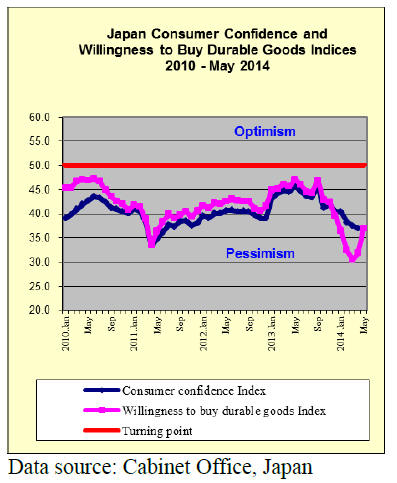
Pace of house building in disaster areas disappointing
Japan‟s housing starts grew steadily in the final quarter of
2013 but slowed in the first quarter of 2014. While there
are signs that the economy may be improving, not all is
well in the housing sector.
As of the end of April over 60,000 families from the area
surrounding the Fukushima nuclear plant are still living in
temporary accommodation.
It is now three years since they evacuated and while they
were offered free housing for a short period, prospects for
a permanent solution are dim.
The pace of new home building for those in the disaster hit
areas has been slow and now, with construction work for
the 2020 Tokyo Olympics already underway, construction
workers find they can earn more working in Tokyo.
The latest data from the Ministry of Land, Infrastructure,
Transport and Tourism shows that May housing starts fell
15% year on year, much more than forecast.
See:
www.e-stat.go.jp/SG1/estat/NewListE.do?tid=000001016966
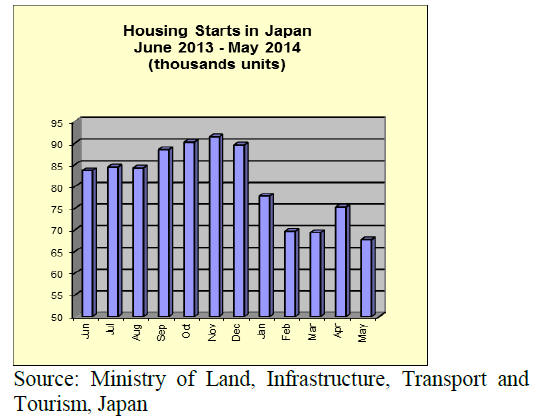
‘Third arrow’ of growth plan revealed
The Japanese cabinet has approved and released a growth
strategy aimed at revitalising the economy and restoring
the country's global competitiveness.
The latest of the growth plans is the so-called „third arrow‟
of the prime ministers offencive against deflation. The
plan includes over 240 proposals affecting labour
regulations, government pension fund investments,
corporate governance and tax policies, expanded childcare
to bring more women into the workforce and an
investment boom.
These measures, say the ruling party, are what are needed
to unlock stalled corporate investment and stimulate
innovation.
While economists have applauded the concepts in the plan
their fear is that details, like the size and timing of the
changes are either vague or unspecified.
Many of the proposals will only apply to enterprises in the
new "special economic zones" which will be free of much
of the bureaucratic hurdles which constrain the private
sector.
Trends in office, kitchen and bedroom furniture
imports
Japan‟s office kitchen and bedroom furniture imports from
2009 to the end of May 2014 are shown below.
As anticipated, Japan‟s furniture imports eased in May. A
Sharp decline was seen in both kitchen and bedroom
furniture imports with office furniture imports remaining
at about the same level as in April.

May imports of office furniture into Japan increased 7%
compared to April levels. China maintained its number
one ranking as the main supplier and in May increase
exports to japan by 30%.
Poland was ranked second and Portugal third in terms of
the value of exports of office furniture to Japan. The top
three suppliers accounted for over 70% of all office
furniture imports.
Kitchen furniture imports (HS 9403.40)
The top three suppliers of kitchen furniture to Japan in
May remained Vietnam, 36.7% (39.5% in April), China,
19.8 % (20.1% in April) and Indonesia 17.2% almost the
same as in April.
Of the non-Asian suppliers only Germany fearures
prominently in May, accounting for 5.5% of Japan‟s
kitchen furniture imports. The top three suppliers. plus
Philippines, accounted for around 90% of May kitchen
furniture imports by Japan.
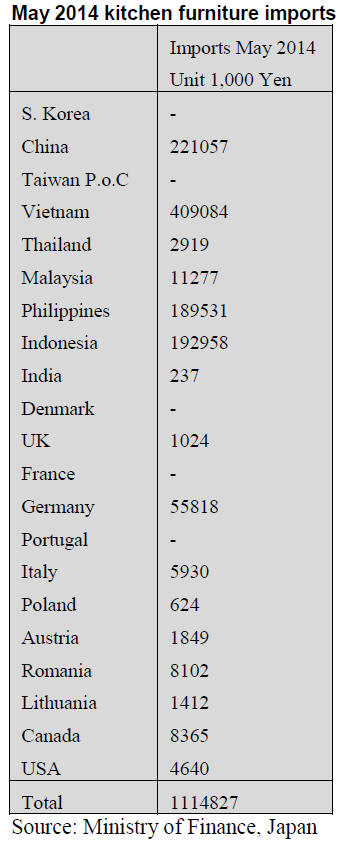
Bedroom furniture imports (HS 9403.50)
April bedroom furniture imports were largely unchanged
and so avoided the downturn seen with office and kitchen
furniture imports however, May figures show a sharp
correction. Japan‟s May imports of bedroom furniture fell
13% with the top three suppliers, China, Vietnam and
Thailand all recording significant declines.
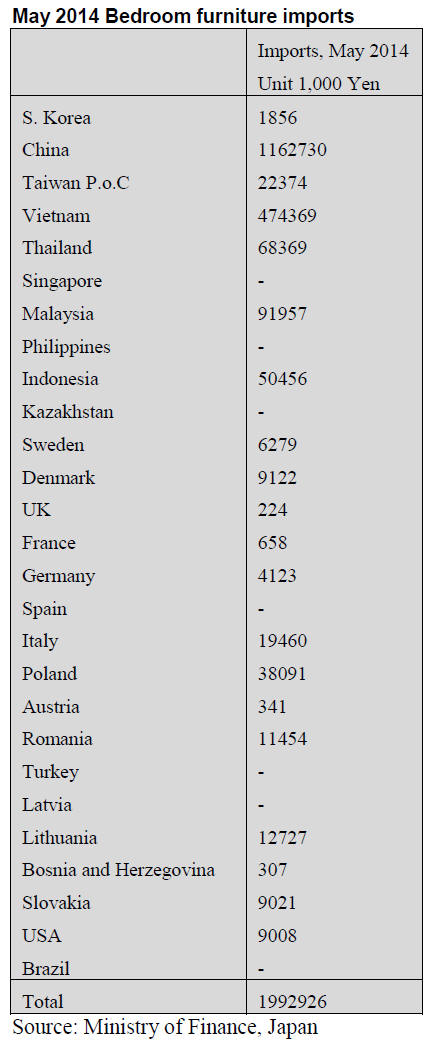
For the JLR report please see:
http://www.nmokuzai.
com/modules/general/index.php?id=7
Wood Use Point System
The administration office of the Wood Use Point System
of the Forestry Agency announced on May 29 that it added
three foreign species as qualified species for the system.
They are European spruce, red pine from Sweden and
radiate pine from New Zealand.
Each prefecture needs to approve above added species and
construction method for the system. Newly approved
species and type of construction are as follows:
Prefecture of Gifu, Fukui, Nagano approved post
and beam construction built with majority of
structural members by cedar, cypress, larch, fir,
red pine, black pine, Ryukyu pine and yellow
cedar or American Douglas fir for the system.
Prefecture of Kanagawa, Gifu, Shiga, Fukuoka,
Nagasaki approved log house and platform
construction with cedar, cypress, larch, fir and
American Douglas fir.
Prefecture of Hokkaido, Ibaraki, Tokyo,
Kanagawa, Nagano, Miye, Shiga, Osaka, Hyogo,
Wakayama, Okayama, Hiroshima and
Yamaguchi approved post and beam construction
with cedar, cypress, larch, fir, red pine, black
pine, Ryukyu pine, yellow cedar, American
Douglas fir and Austrian spruce.
By all those approvals, American Douglas fir is qualified
for both post and beam and platform construction in 42
prefectures and log house in 41 prefectures.
April plywood supply
Total supply of plywood in April was 587,700 cbms, 0.8%
more than April last year and 5.3% more than March. This
is the second highest next to last January. In particular,
domestic monthly production was the highest this year but
the inventories were only half month yet. Imported
plywood was also high.
Volume of imported plywood was 325,100 cbms, 3.7%
less and 6.1% more. Monthly average volume in last four
months was 319,200 cbms, 0.2% more than the same
period of last year. Malaysian volume increased by about
20,000 cbms from March to 147,700 cbms, 10.5% less and
15.1% more.
Monthly average for last four months was 137,800 cbms,
7.6% less than the same period of last year. Indonesian
volume was 90,200 cbms, 2.5% less and 7.4% less.
Four month average is 91,300 cbms, 2.0% more. Volume
from China was 74,000 cbms, 1.9% less and 6.2% more.
Four month average was 69,300 cbms, 4.0% more.
Malaysia suffered log shortage since late last year and it is
reported that even major mill had about 20% less
production in February. However, Japan side is cautious in
buying futures with ambiguous market so the arrivals from
Malaysia seem to stay low.
Domestic production in April was 252,500 cbms, 7.4%
more and 4.1% more.
2013 Forestry white paper
The government approved 2013 forestry white paper on
May 30, which contains trend of forest and forest industry
in 2013 and forestry measures for 2014.
The stock of artificial forest increased by 5.4 times in fifty
years. Timber of more than 45 years old takes a majority
of 5,230,000 hectares so the future subjects are harvest,
utilization and replantation of rejuvenation of matured
forests. Also development of new demand and
establishment of stable supply system are needed.
The paper explained history of forestry after the war.
Increase of stock by aggressive plantation but harvest and
maintenance of forest was not properly done by expansion
of import of foreign logs and lumber by strong yen. It
emphasizes that it is important to have circulation cycle of
planting, harvesting, consuming then replanting.
Plywood
Plywood market turned weak since May on both domestic
and imported products. April production of domestic
softwood plywood was 236,300 cbms, 4.2% more than
March, the second highest monthly production next to
October 2013 then the shipment was 218,300 cbms, 1.8%
less than March.
The inventories increased to 114,800 cbms, 19.6% more
than March but they are way shorter than one month
inventory so the manufacturers are not worried and stay
bullish. Meantime, trading firms and wholesalers are
reducing the sales prices to secure sales amount and
protect their market.
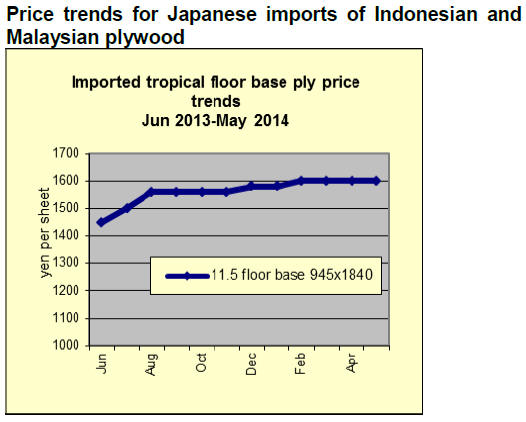
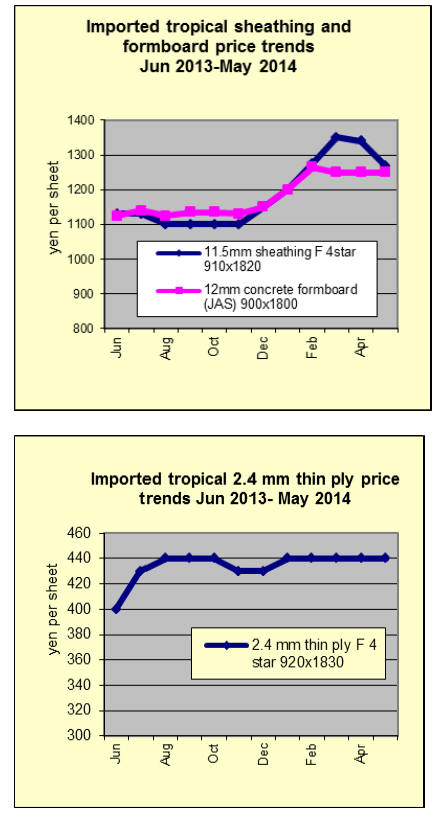
Market of imported plywood is also softening. Weakening
softwood plywood market is influencing imported
plywood market and trading is limited in small volume.
In particular, 12 mm structural panel and 3x6 concrete
forming panel are weak. Imported structural panel
supplemented short supplied domestic softwood panels
since late last year but after domestic supply became ample, it finished its
role
and the inventories increased.
Since last April, some trading firms started selling at lower
prices so the prices have been down. Concrete forming
and concrete forming for coating had rather firm market
but since late May, they started weakening.
Production of preserved wood for the first quarter
Japan Wood Preservers Industry Association disclosed
production of pressurized preservative wood for the first
quarter this year is 48,577 cbms, 5.5% higher than the
same period of last year. Production of preserved wood for
sill is up by 3.7%.
Percentage of pressurized preserved wood for residential
housing is 82%, out of which 53% is for ground sill so
consumption of sill has influence on the production.
In the first quarter production, 25,731 cbms is for sill,
3.7% more than the first quarter last year. 14,301 cbms for
housing like post, lintel, furring strip and sheathing for
ceiling, 3.4% more, almost the same growth with sill.
The most grown item is exterior materials like decking,
which was 3,987 cbms, 16.8% more. Also the production
for others like crating, gardening and engineering works
was 2,709 cbms, 43.9% more.Railroad tie and telephone poles, which
used to be the main items for preserved wood declined
after concrete products replaced wood.
Rail tie production was 1,826 cbms, 12% down and
telephone pole was only 23 cbms, 58.9% down.
|